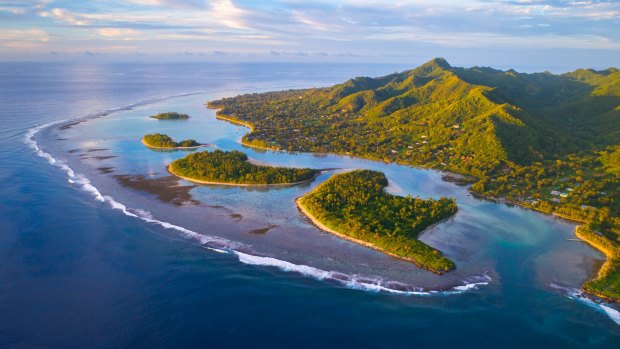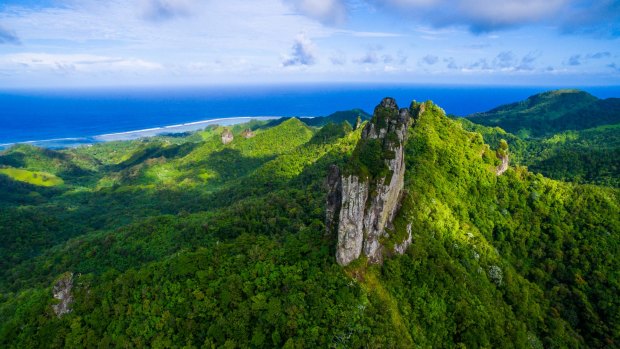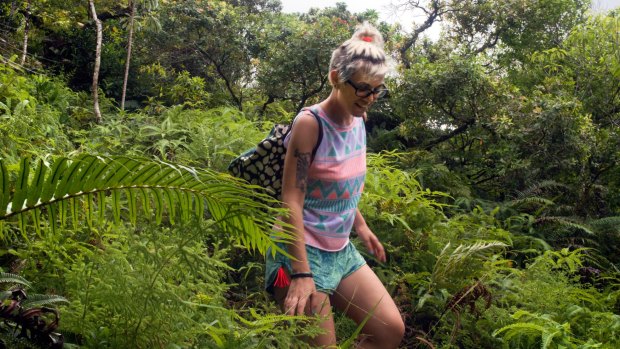This was published 5 years ago
Cook Islands hiking trails: Cross-island walk is not your typical experience in paradise
By Craig Platt
This is not how most people envisage paradise.
My legs are aching, I'm drenched in sweat and my shoes are covered in mud. But I still feel pretty great.
I'm on Rarotonga, the largest of the Cook Islands, making my way across the island's interior on a mountain hike. While other tourists are lazing on the beach or snorkelling in the lagoon, our small group is crossing the island, following an ancient, overgrown track.

While most visitors to the Cook Islands still to the beaches and lagoons, there's plenty to see in the interior.
The hike starts off easy enough. We follow a dirt road past houses and small farms, occasionally passing friendly dogs and snuffling pigs. In the distance, our first goal, the rocky, pointed peak of Te Rua Manga (the Needle), can be seen.
Quickly the climb becomes much more arduous. The path gets steeper and muddier and is covered by slippery, thick tree roots. The foliage closes in around us and the tropical air becomes even more humid, though I'm grateful we're now shaded from the sun. Although the brochure says hiking boots or sneakers would be fine, I'm wearing my beat-up old Converse instead of something more appropriate.
It might sound hard, but we're getting the most difficult part of this trek out of the way first. After all, Rarotonga is a tiny speck of an island – you can drive around it in about 45 minutes. Our guided cross-island walk is going to take only little more than three hours.

Spectacular views over the island can be enjoyed from the rocky, pointed peak of Te Rua Manga (the Needle).
We climb 400 metres to reach the Needle, where the more adventurous among us use ropes and chains fixed to the rock to get a little closer to the peak. From here, it's a sheer drop over the side of about 100 metres. Peering over the edge, I can see birds circling in the valley below me.
Resting at the top, our guide, Bruce from Pa's Treks, tells us a bit about the history of the island and its ecology. The locals traditionally lived here in the highlands, he says, before Christian missionaries convinced them to move to the coast. It's here in the interior that the island's native flora still survives – on the coast it has been overwhelmed by introduced species.
Evidence of this highland culture still exists and is shared at the Highland Paradise cultural show, where I head in the evening after the hike. Traditional music and dance is held adjacent to an ancient marae – a sacred place marked by rocks where ceremonies would be held. Here the locals are rediscovering their native culture and history, years after Christian missionaries tried to phase it out.

Hiking through the highlands with Pa's Treks. Credit: Alamy
The Cook Islands remain a very Christian nation – most places are closed on Sundays and churches are full. I'm told that on the nearby island of Aitutaki, locals still occasionally stage protests at the airport, unhappy that it continues to operate on Sunday.
I don't need any prayers on the downward trail from our hike, though I may blaspheme a few times. Coming down may not get my heart pumping like the climb, but it's arguably more arduous. There are occasionally steep drops, requiring us to navigate our way down backwards, gripping tree trunks, roots or anything else we can get our hands on to steady ourselves. I take a couple of tumbles on the slippery mud, though all that's hurt is my pride and my shorts.
Fortunately Rarotonga's jungle isn't overrun with creepy crawlies. There are virtually no dangerous animals here, apart from mosquitoes. Even the plants are mostly benign, so when I'm grabbing at branches, I don't feel the need to constantly check where I'm putting my hands for fear of coming into contact with a spider, snake or thorny bush.
We finally end the hike by stepping out of the thick jungle into a car park. A few metres beyond that is a waterfall, where we're able to take a quick dip to cool off and wash away some of the mud.
Before we depart, the originator of the walking tours and the trail we follow, Pa himself, comes to greet us while we enjoy a picnic lunch. After 30 years, Pa still guides gentler nature walks that focus on herbs and bush tucker, but these days he leaves the more arduous cross-island hike to others to guide.
The next day we're back at the lagoon, snorkelling in the crystal clear water among the multi-coloured fish and coral. While the visit to the highlands has been a rewarding experience, it's nice to get back to the cliche of paradise.
TRIP NOTES
MORE
FLY
Air New Zealand flies to the Cook Islands direct from Sydney once a week, but has connections through Auckland 13 times a week. See airnewzealand.com.au
See also: Airline review: Air New Zealand premium economy, Cook Islands to Sydney
HIKE
The guided cross-island trek costs $NZ79 a person including hotel transfers and lunch. The trek takes 3-3½ hours. A reasonable level of fitness and sturdy shoes are recommended. Note that the full cross-island trek will not be available in 2019 until November, due to infra-structure works on the island. The hike will instead go to the Needle and return the same way. See pastreks.com
EXPERIENCE
The Highlands Paradise sunset dinner and cultural show costs $NZ110 for adults and $NZ65 for children, including transfers from your accommodation. See cookislands.travel/activity-provider/highland-paradise
STAY
One of the pleasant things about the Cook Islands is that the they are not overrun with large resorts. There is an abundance of smaller, family-run villas, B&Bs and small hotels. We stayed at Crystal Blue Lagoon Luxury Villas, two-storey, two-bedroom villas located right on Rarotonga's Muri Lagoon with handy access to lagoon cruises and other water activities. Rates from $NZ720 a night. See crystalbluelagoonvillas.com/
The writer travelled as a guest of Cook Islands Tourism.
See also: A place so beautiful it doesn't seem real, but it is
See also: Twenty reasons to love the Cook Islands
Sign up for the Traveller Deals newsletter
Get exclusive travel deals delivered straight to your inbox. Sign up now.